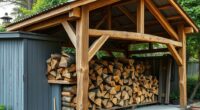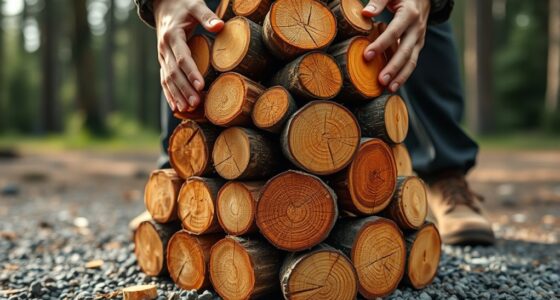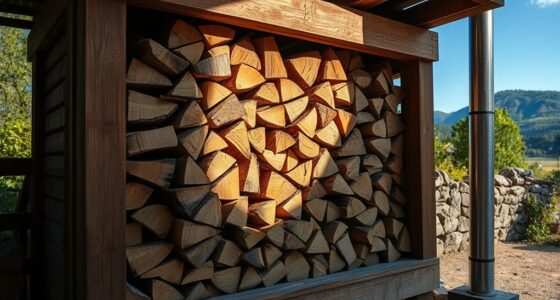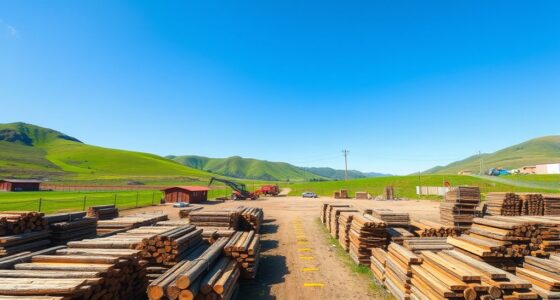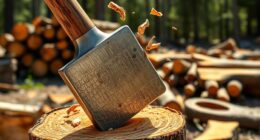To upcycle log offcuts into outdoor seating, start by selecting durable hardwoods like oak or maple, ensuring they’re free from cracks and proper moisture levels. Plan your design carefully, then use safety gear and sharp tools to cut and shape the logs. Assemble sturdy, weather-resistant structures, sand smooth edges, and apply sealants to protect against the elements. For more creative ideas and detailed steps, keep exploring how you can transform your logs into charming outdoor furniture.
Key Takeaways
- Select durable hardwood logs, inspect for damage, and prepare appropriate sizes for safe, weather-resistant outdoor seating.
- Use proper safety gear and tools, securing logs firmly to ensure precise, safe cutting and shaping of the seating components.
- Design and assemble the logs into stable structures, applying sealing and finishing techniques to protect against moisture and decay.
- Customize with paint, carvings, or cushions to enhance aesthetics and comfort, ensuring longevity through regular maintenance.
- Incorporate eco-friendly upcycling methods, highlighting natural wood features while ensuring durability for outdoor use.
Selecting the Right Log Offcuts for Seating Projects
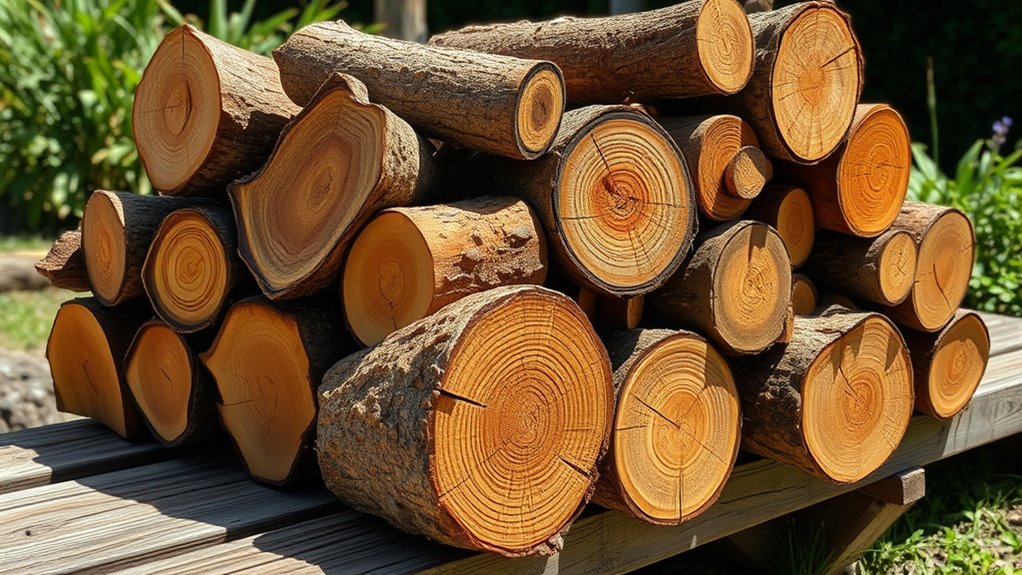
Choosing the right log offcuts is essential for creating sturdy, comfortable seating projects. When selecting logs, consider the types of wood; hardwoods like oak, maple, or hickory are durable and ideal for outdoor furniture, while softwoods like pine or cedar are lighter and easier to work with. Inspect each log carefully for cracks, splits, or rot, as these weaken the structure. Confirm the logs are the appropriate size and shape for your design, avoiding pieces with irregularities that could compromise stability. Think about the logs’ moisture content—dry logs are less likely to warp or crack over time. Additionally, understanding cultural heritage of natural surroundings can inspire respectful and environmentally conscious design choices. Recognizing wood durability factors can help you select logs that will stand up to outdoor conditions and last for years. Considering environmental sustainability can also guide responsible sourcing and eco-friendly project decisions. Selecting logs with proper moisture content can prevent future issues like warping or splitting, ensuring longevity. By carefully selecting logs based on type, condition, and size, you set a strong foundation for creating long-lasting, comfortable outdoor seating.
Planning Your Outdoor Seating Design

Once you’ve selected the right logs, it’s time to plan your outdoor seating layout. Think about how you want your seating to blend with your garden decor and prioritize seating comfort. Sketch a rough layout, considering space for movement and views. Use logs of different sizes to create a dynamic design, balancing aesthetics and function. Incorporating design principles can help achieve a harmonious and functional layout, especially when considering log sizes and arrangements to optimize comfort and style. Additionally, paying attention to material durability ensures your seating withstands outdoor conditions over time. Leveraging upcycling techniques can add a unique and eco-friendly touch to your project. Considering well-being tips, such as using supportive and comfortable materials, can also contribute to a more inviting outdoor space.
Preparing and Cutting the Wood Safely

Before you start cutting your log offcuts, make sure you wear protective gear like goggles and gloves to keep yourself safe. Always use the right tools and make certain they are sharp and in good condition for clean cuts. Secure the wood firmly to prevent slipping and accidents while you work. Additionally, understanding the types of tools suitable for woodworking can help ensure you choose the right equipment for a safe and efficient project. Using the appropriate safety equipment can further reduce the risk of injury during cutting. Incorporating knowledge of sound vibrations can also improve your focus and precision during the process.
Wear Protective Gear
Because cutting wood can produce flying debris and loud noise, it’s essential to wear protective gear every time you work. Safety precautions help prevent injuries and keep you safe during your project. Always wear safety goggles to shield your eyes from wood chips and dust, and use ear protection to guard against loud noises that can damage your hearing. Gloves can protect your hands from splinters and rough surfaces, but make sure they fit well so they don’t interfere with your grip. A dust mask is also recommended to avoid inhaling sawdust, especially when working without proper ventilation. Remember, taking these simple precautions minimizes risks and makes your upcycling project safer and more enjoyable. Proper safety measures are crucial to ensure a successful and injury-free woodworking experience. Never skip wearing your protective gear. Additionally, understanding nail styles can inspire creative ways to finish your project with a personalized touch. Incorporating safety guidelines from reputable sources can further enhance your safety during woodworking tasks. For added safety, consider using dust extraction tools to reduce airborne particles and dust in your workspace. Using quality tools can also improve safety and precision during your project.
Use Proper Tools
Using the proper tools is crucial to safely preparing and cutting your log offcuts. A sharp circular saw helps you make clean, straight cuts quickly and reduces the risk of kickback. Confirm the blade is suitable for hardwood and that it’s properly installed before starting. When shaping or refining edges, chiseling can be effective, but only if you use the right chisel and a hammer or mallet. Always keep your tools sharp and well-maintained to ensure safer, more precise cuts. Before cutting, double-check your measurements and secure the wood firmly to prevent slipping. Wearing protective gear, like goggles and gloves, is indispensable while operating these tools. Proper technique and the right tools will make your upcycling project safer and more successful. Additionally, understanding appropriate safety procedures helps minimize accidents and ensures a smoother workflow.
Secure the Wood
To guarantee safe and accurate cuts, securing your log offcuts firmly in place is essential. Use clamps or a sturdy vise to prevent movement during cutting. Pay attention to the wood grain; cutting with the grain reduces splintering and provides cleaner results. Check knot stability before cutting near knots, as loose or unstable knots can cause the wood to split unpredictably. Mark your cut lines clearly and double-check measurements to ensure precision. Firmly securing the wood minimizes the risk of slipping, which can lead to accidents or uneven cuts. Remember, stable positioning makes all the difference in achieving smooth, safe cuts. Properly prepared and secured wood helps you work confidently and produces better results for your outdoor seating project.
Assembling Your Log Seat or Bench
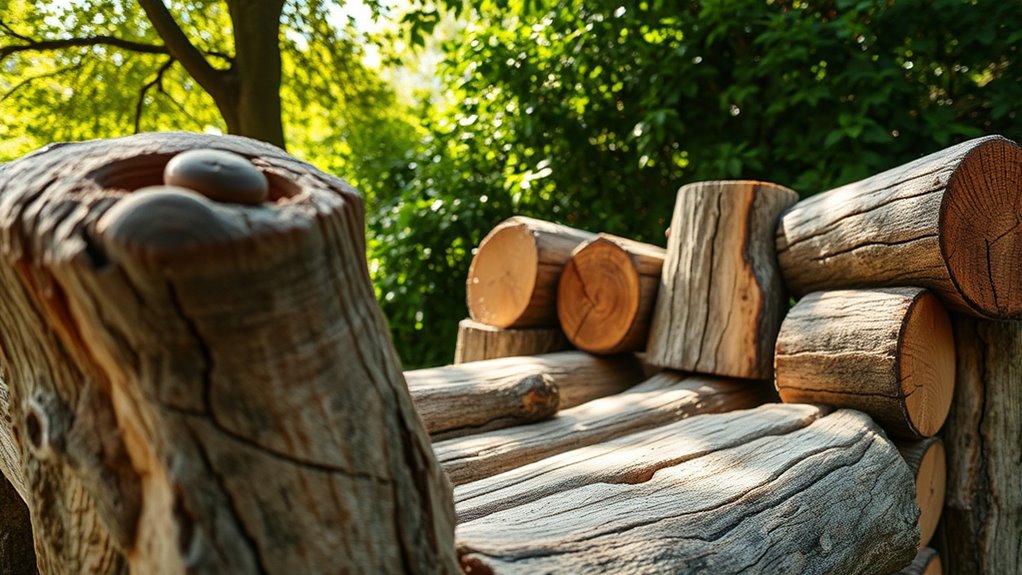
Once you’ve selected your log pieces, it’s time to start assembling your seat or bench. Focus on maintaining the wooden aesthetics, ensuring each piece fits securely. Use sturdy brackets or natural joinery techniques to connect the logs, which enhances stability and highlights the sustainability benefits of repurposed wood. Arrange the logs in your preferred configuration:
| Log Position | Connection Method | Notes |
|---|---|---|
| Seat Top | Notched joints | Showcases natural edges |
| Legs | Metal brackets | Adds stability |
| Support Beam | Bolts or screws | Reinforces structure |
| Backrest | Wooden dowels | Complements design |
Take your time aligning each piece. Proper assembly guarantees your outdoor seating is durable and visually appealing, celebrating both craftsmanship and eco-friendliness. Proper assembly is crucial to ensure the longevity and stability of your upcycled log bench, especially considering the wave and wind factors that can impact outdoor structures. Additionally, selecting the right location for your log seat will help it withstand the elements over time. Incorporating proper sealing techniques can further protect the wood from moisture and decay, extending the lifespan of your bench.
Finishing Touches: Sanding, Sealing, and Protecting

Once you’ve assembled your log piece, it’s time to focus on finishing touches. Sand the surface smoothly, seal it to guard against moisture, and add a weatherproof finish if it’s outdoors. These steps guarantee your project looks great and lasts for years to come.
Sanding for Smoothness
Sanding for smoothness is a essential step in transforming rough log offcuts into polished, appealing pieces. It reveals the natural grain pattern, enhancing the wood’s visual charm. Using proper sanding techniques, start with coarse grit to remove splinters and uneven surfaces. Gradually switch to finer grits, working in the direction of the grain to avoid scratches. Pay close attention to edges and curves, ensuring every surface feels smooth to the touch. Sanding not only improves the appearance but also prepares the wood for sealing and protecting. Take your time and use even pressure to prevent gouges. Once finished, wipe away dust with a damp cloth, revealing a beautifully smooth surface ready for the next finishing steps.
Sealing to Protect
After achieving a smooth surface through careful sanding, sealing is essential to protect your upcycled log offcut from moisture, stains, and wear. Applying a quality sealant creates a durable barrier that preserves the wood’s integrity. When sealing, consider your staining techniques; a clear sealant enhances natural grain, while tinted options can add color or depth. Sealing also offers an opportunity to incorporate decorative accents, such as subtle patterns or painted details, which can personalize your outdoor seating. Use a brush or sprayer for even coverage, paying attention to joints and textured areas. Allow the sealant to dry thoroughly before moving on to the next step. Proper sealing extends the lifespan of your project, ensuring it remains beautiful and resilient outdoors.
Applying Weatherproof Finish
With your log offcut now sealed, it’s time to add a weatherproof finish that protects your project from the elements. Choose weather resistant finishes designed for outdoor use to guarantee durability. Apply a coat of eco friendly sealants that are both effective and environmentally conscious. These finishes penetrate the wood, creating a barrier against moisture, UV rays, and temperature fluctuations. Use a brush or sprayer for even coverage, paying attention to all surfaces and edges. Allow the sealant to dry completely before applying additional coats if needed. This step enhances the longevity of your seating and maintains its appearance over time. Properly finished, your upcycled log seat will withstand weather conditions while showcasing your sustainable craftsmanship.
Creative Ideas for Customizing Your Log Seating
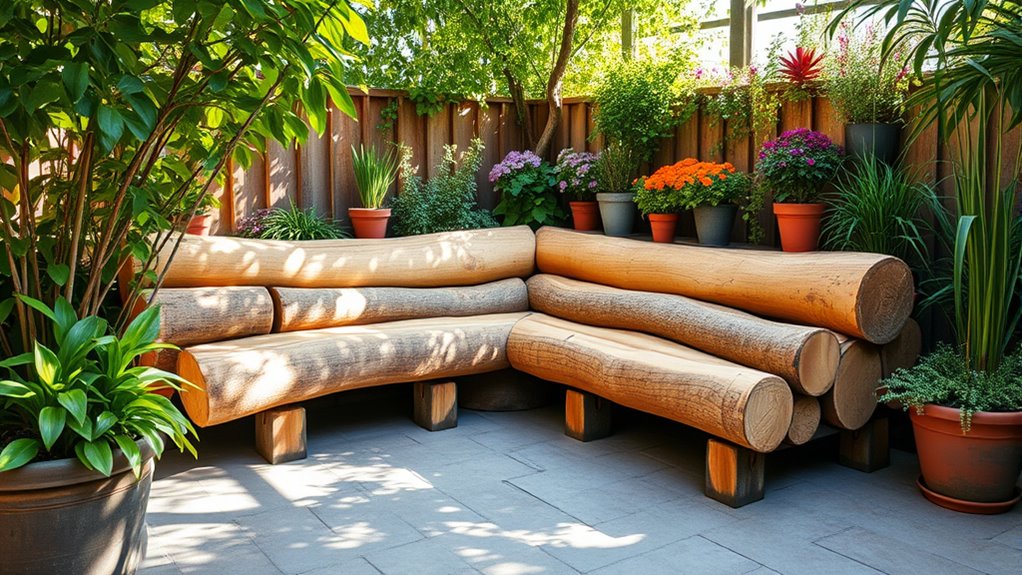
Transforming your log seating into a personalized statement is easier than you might think. You can customize it to match your outdoor style with simple ideas.
Here are four creative ways to do it:
- Choose from a variety of log color options to brighten or tone down your seating.
- Add decorative carvings or engraved patterns to give your log a unique look.
- Paint or stain sections for a colorful, artistic touch.
- Attach handcrafted cushions or pillows for comfort and style.
These ideas allow you to express your personality while enhancing your outdoor space. Whether you prefer bold colors or subtle details, customizing your log seating makes it truly one-of-a-kind.
Caring for and Maintaining Your Upcycled Outdoor Furniture
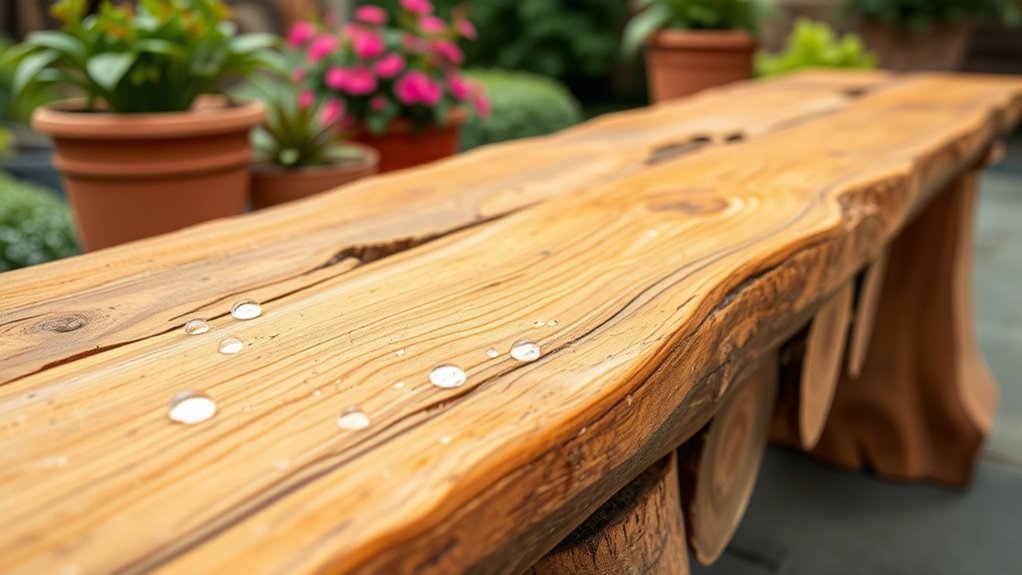
To keep your upcycled outdoor furniture looking its best, regular maintenance is essential. Clean your pieces with mild soap and water to remove dirt and prevent buildup that can harm the wood. Applying a protective sealant or outdoor paint every couple of years helps preserve the wood and maintain your patio decor’s charm. Cover your furniture during harsh weather or store it indoors to prevent damage from moisture and sun exposure. This upkeep not only prolongs the lifespan of your upcycled seating but also enhances your garden aesthetics, keeping your outdoor space inviting and stylish. Check for loose joints or splinters regularly, and repair them promptly to avoid further damage. Proper care guarantees your furniture remains a beautiful, functional addition to your outdoor haven.
Frequently Asked Questions
What Types of Wood Are Best Suited for Outdoor Log Seating?
When choosing the best types of wood for outdoor log seating, you should consider suitable log wood that withstands weather conditions. Hardwoods like cedar, redwood, and teak are ideal because they resist rot and insects, making them durable. Softwoods like pine can work if properly treated with sealants and preservatives. Always select wood with natural oils or treatments that enhance longevity, ensuring your outdoor seating remains sturdy and attractive over time.
How Do I Ensure Stability and Safety in My Log Seat Design?
Imagine your outdoor seat as a sturdy ship; stability is key. To achieve this, focus on proper weight distribution by balancing the log’s weight evenly. Use effective anchoring methods like ground anchors or heavy-duty stakes to prevent shifting. Reinforce joints with strong fasteners, and consider adding a wide base for extra support. With these steps, your log seat will remain safe and stable, inviting everyone to sit and enjoy.
Can I Incorporate Built-In Features Like Storage or Footrests?
You can definitely incorporate integrated storage and a built-in footrest into your outdoor log seat. To do this, carve out a hollow section beneath the seat for storage, ensuring it’s sealed and weatherproof. For a built-in footrest, attach a sturdy, level piece at a comfortable height. Just make sure all features are securely fastened and smooth to prevent splinters or injuries, keeping your seat both functional and safe.
What Environmentally Friendly Finishes Are Recommended for Outdoor Use?
You might wonder what finishes are best for outdoor projects. Eco-friendly stains and natural sealants are excellent choices because they protect wood while being gentle on the environment. These finishes penetrate deeply, resisting weather and decay without harmful chemicals. By choosing eco-friendly stains or natural sealants, you guarantee your outdoor seating stays beautiful and sustainable, proving that environmentally conscious options can be both effective and stylish for outdoor furniture.
How Long Does a Finished Log Seat Typically Last Outdoors?
Your finished log seat typically lasts 3 to 7 years outdoors, depending on weather resistance and maintenance. To prolong its lifespan, apply a high-quality outdoor sealant or stain, and reapply it annually. Keep the seat clean and dry, and consider covering it during harsh weather. Proper maintenance, including inspecting for damage and resealing when needed, helps make sure your outdoor seating remains durable and inviting for years to come.
Conclusion
By upcycling log offcuts into outdoor seating, you not only create unique furniture but also reduce waste. Did you know that over 300 million tons of wood waste end up in landfills annually? Your DIY project helps cut that number and supports sustainable living. With a little effort, you can craft beautiful, eco-friendly seats that enhance your outdoor space while making a positive environmental impact. Start your upcycling journey today and enjoy the benefits of creative, green living.

